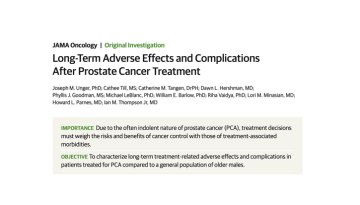Hodgkin Lymphoma Trial Results: A Homerun
Happy tax day! This week, the lymphoma and imaging committees are giving back to you and our patients thanks to reseach by Dr. Oliver Press and his SWOG team.
Press, a SWOG investigator at the Fred Hutchinson Cancer Research Center, was the lead author of an article published Monday in the Journal of Clinical Oncology. Press and his team found that using PET imaging to guide chemotherapy significantly increases the remission rate, while decreasing toxicity in patients with advanced stage disease. The study, S0816, is the first large-scale U.S. trial to test this treatment approach with people with Hodgkin lymphoma, which struck an estimated 9,050 Americans last year.
Press and his team, which included SWOG Lymphoma Committee Chair Dr. Jonathan Friedberg and our partners at ECOG-ACRIN, the Alliance, and the AIDS Malignancy Consortium, tested “response-adapted therapy” for patients with Stage III and IV Hodgkin lymphoma. Investigators recruited 358 patients, 336 of whom were evaluable. Patients were given two rounds of ABVD, the standard front-line chemotherapy regimen for the last 20 years. Then, everyone received a PET scan to gauge response.
PET-negative patients received a final four cycles of ABVD. Patients whose scan was positive, however, were given six cycles of escalated BEACOPP, which is felt to be slightly more effective but also more toxic. The authors stated most oncologists want to avoid over-treating the 70% of patients cured with ABVD, while also improving the cure rate itself.
Results from S0816 were striking. Typically, if Hodgkin patients get two rounds of ABVD treatment, and a PET scan still shows the presence of cancer, about 15 to 30 percent will be progression-free after two years. However, results showed that 64 percent of patients who were switched to eBEACOPP treatment after the positive scan were in remission after two years. You can do the math. That’s more than double the expected remission rate! Not surprisingly, patients who had a clear scan and were treated exclusively with ABVD treatment fared pretty well. In this group, 79 percent were progression-free after two years.
The work sparked a favorable JCO editorial. Penned by researchers from the German Hodgkin Study Group and the University Hospital of Cologne, the editorial praised the Phase II trial for its “remarkable” enrollment. The authors predicted that other risk-adapted treatment approaches will “create new opportunities for patients with advanced stage Hodgkin lymphoma,” possibly including targeted drugs or checkpoint inhibitors.
A particularly interesting point: We often consider genetic screening as necessary to offer personalized therapy. Press and his team did tailor treatment to each patient. But, of course, they were not looking for targetable mutations. Here, imaging showed us that a variety of approaches can fall under the rubric of personalized care.
I offer strong congratulations to Dr. Press and the team. This wonderful example of intergroup collaboration will help treating physicians ease the burden of those touched by one specific malignancy – with potential applicability to others.
Other Recent Stories



